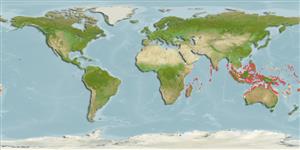Teleostei (teleosts) >
Gobiiformes (Gobies) >
Gobiidae (Gobies) > Gobiinae
Etymology: Istigobius: Greek, istios = sail + Latin, gobius = gudgeon (Ref. 45335).
Eponymy: Charles Francis Spence (1907–1982) was a businessman in Mozambique, the type locality, whom Smith thanked for providing personal assistance. Spence later published: The Portuguese Colony of Moçambique: an Economic Survey (1951). (Ref. 128868), visit book page.
More on author: Smith.
Environment: milieu / climate zone / depth range / distribution range
Ecology
Marine; brackish; reef-associated; depth range 1 - 12 m (Ref. 90102). Tropical; 15°N - 40°S
Indo-Pacific: Mozambique, Kenya, Sri Lanka, Papua New Guinea, Australia, and Micronesia; undoubtedly more widespread.
Size / Weight / Age
Maturity: Lm ? range ? - ? cm
Max length : 7.9 cm SL male/unsexed; (Ref. 1602)
Dorsal spines (total): 7; Dorsal soft rays (total): 10 - 11; Anal spines: 1; Anal soft rays: 9 - 10; Vertebrae: 26. Pectoral fin rays entire. Predorsal cycloid scale 7-10, ctenoid on trunk. Few spots on nape; a dusky line running from eye dorsal to sensory pore path, ending at or before pectoral fin base; wavy brown lines on the snout. Pelvic and distal part of anal fins darker in males than in females. Appressed anal fin reaching within a distance of 1-2 scales of caudal fin in male, 2-4 scales in female; appressed 2nd dorsal slightly overlapping caudal in male. Some males exhibit 3-4 vertical bars on abdomen and 2-3 horizontal bars in 1st dorsal fin (Ref. 420); longitudinal scale series 30-32; no scales on cheek and opercle; body depth 4.9-6.1 in SL (Ref. 90102).
Occurs in turbid coastal areas near river mouths at less than 1 m to at least 12 m, Ref. 48637.
Life cycle and mating behavior
Maturity | Reproduction | Spawning | Eggs | Fecundity | Larvae
Genital papilla of male reaching anal spine. Female genital papilla truncate, ending well before origin of anal fin.
Murdy, E.O. and D.F. Hoese, 1985. Revision of the gobiid fish genus Istigobius. Indo-Pac. Fish. (4):41 p. (Ref. 420)
IUCN Red List Status (Ref. 130435: Version 2024-2)
Threat to humans
Harmless
Human uses
Tools
Special reports
Download XML
Internet sources
Estimates based on models
Preferred temperature (Ref.
123201): 25.7 - 29.3, mean 28.6 °C (based on 2615 cells).
Phylogenetic diversity index (Ref.
82804): PD
50 = 0.5010 [Uniqueness, from 0.5 = low to 2.0 = high].
Bayesian length-weight: a=0.01023 (0.00477 - 0.02194), b=3.01 (2.83 - 3.19), in cm total length, based on LWR estimates for this (Sub)family-body shape (Ref.
93245).
Trophic level (Ref.
69278): 3.3 ±0.4 se; based on size and trophs of closest relatives
Resilience (Ref.
120179): High, minimum population doubling time less than 15 months (Preliminary K or Fecundity.).
Fishing Vulnerability (Ref.
59153): Low vulnerability (10 of 100).
Nutrients (Ref.
124155): Calcium = 139 [69, 301] mg/100g; Iron = 0.849 [0.417, 1.558] mg/100g; Protein = 18.7 [16.7, 20.3] %; Omega3 = 0.153 [0.067, 0.292] g/100g; Selenium = 16.6 [8.1, 37.8] μg/100g; VitaminA = 145 [39, 485] μg/100g; Zinc = 2.53 [1.67, 3.75] mg/100g (wet weight);
